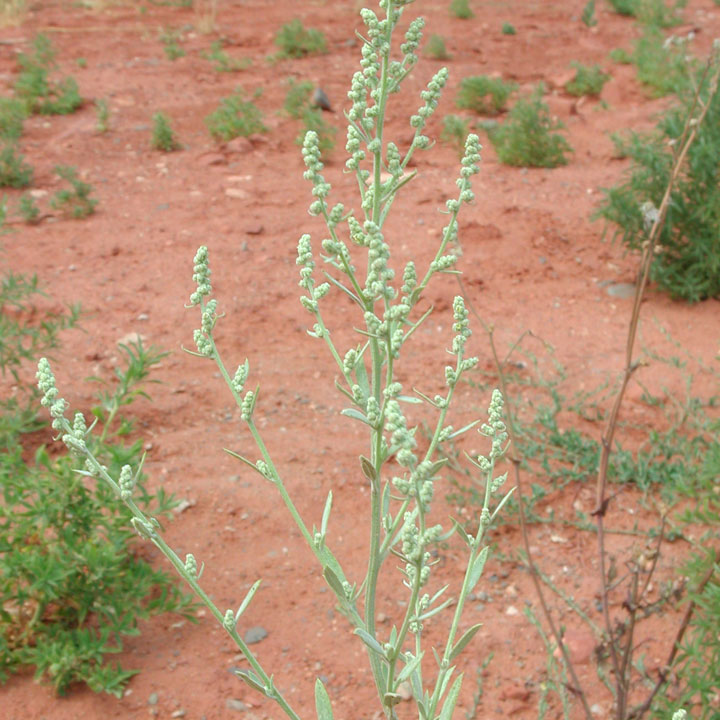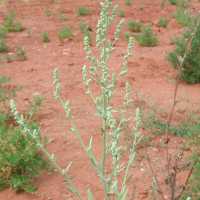Stems strictly erect, simple or branching above, 2-8 dm, moderately to densely farinose. Leaves nonaromatic; petiole 0.4-1 cm; blade linear to narrowly lanceolate, or oblong-elliptic, (1- or)3-veined, 1.5-4.2(-6) × 0.4-1(-1.4) cm, thick and somewhat fleshy, base cuneate, margins entire or with pair of lobes near base, apex acute, abaxial surface densely to sparingly white-mealy. Inflorescences glomerules in terminal and axillary panicles, 1-13 × 0.15-0.5 cm; glomerules usually densely disposed, maturing irregularly; bracts leaflike. Flowers: perianth segments (4-)5, distinct nearly to base; lobes oblong-ovate, 0.8-1 × 0.5-0.7 mm, apex obtuse, rounded or emarginate, strongly keeled along midvein, densely farinose, usually spreading from fruit; stamens (4-)5; stigmas 2, 0.2 mm. Utricles ovoid; pericarp nonadherent, smooth. Seeds round, 0.9-1.3 mm diam., margins rounded; seed coat black, rugulate. 2n = 18.
Fruiting early summer-fall. Open sandy soils, pinyon woodlands, sagebrush, often in saline or alkaline habitats; 0-2400 m; Alta., B.C., Man., N.W.T., Ont., Sask., Yukon; Alaska, Ariz., Calif., Colo., Conn., Idaho, Ill., Ind., Iowa, Kans., Ky., La., Maine, Md., Mass., Minn., Mo., Mont., Nebr., Nev., N.H., N.J., N.Mex., N.Y., N.C., N.Dak., Okla., Oreg., Pa., R.I., S.C., S.Dak., Tex., Utah, Vt., Va., Wash., Wis., Wyo.
Annual herb 20 cm - 0.8 m tall
Stem: upright, unbranched to branched above, moderately to densely white-mealy.
Leaves: alternate, upright to ascending, on a 0.4 - 1 cm long stalk, 1.5 - 4 cm long, 0.4 - 1.5 cm wide, linear to narrowly lance-shaped to narrowly egg-shaped with a tapering base and pointed tip, typically three-veined, sometimes with a pair of basal lobes, thick, somewhat fleshy, sparsely to densely white-mealy beneath.
Inflorescence: a small, dense cluster of flowers (glomerule), which together form upright or ascending spikes, of which form a larger inflorescence (panicle), white-mealy.
Flowers: greenish, small, with five nearly distinct sepals and no petals. Sepal lobes to 1 mm long, oblong egg-shaped with a blunt, rounded, or shallowly notched apex, prominently keeled along midvein, densely white-mealy. Stamens five. Stigmas two.
Fruit: one-seeded (utricle), surrounded by the persistent, spreading sepals, egg-shaped, thin-walled. Wall (pericarp) loose and easily separable from the seed. Seed horizontal, black, shiny, 1 - 1.4 mm wide, spherical, round-margined, wrinkled.
Similar species: No information at this time.
Flowering: June to October
Habitat and ecology: Black Oak savannas, railroad ballast, and sandy waste ground.
Occurence in the Chicago region: native
Etymology: Chenopodium comes from the Greek words chen, meaning goose, and podion, meaning "little foot," referring to the leaf shape of some species.
Author: The Morton Arboretum
Widely distributed west of the Mississippi River, eastward probably only introduced. Highly polymorphic. Found usually in sandy soil.
Indiana Coefficient of Conservatism: C = 3
Wetland Indicator Status:
Duration: Annual
Nativity: Native
Lifeform: Forb/Herb
General: Strictly erect stems, simple or branching above, 20-80 cm tall, moderately to densely farinose.
Leaves: Petiole 0.4-1 cm, blade linear to narrowly lanceolate, or oblong-elliptic, 3-veined, 1.5-4.2 cm by 0.4-1 cm, thick and somewhat fleshy, cuneate base, margins entire or with pair of lobes near base, apex acute, abaxial surface densely to sparingly white-mealy.
Flowers: Glomerules in terminal and axillary panicles, 1-13 cm by 0.15-0.5 cm; densely disposed, maturing irregularly, bracts leaflike; perianth segments 5, distinct nearly to base, lobes oblong-ovate, 0.8-1 mm by 0.5-0.7 mm, apex obtuse, rounded or emarginated, strongly keeled along midvein, densely farinose, usually spreading from fruit; stamens 5, stigmas 2.
Fruits: Ovoid utricles, pericarp nonadherent, smooth; round seeds, black, 0.9-1.3 mm diameter, rounded margins.
Ecology: Open sandy soils, often in saline or alkaline places from sea level to 8,000 ft (2438 m); flowers May-September.
Ethnobotany: Leaves boiled and eaten by the Gila Pima.
Etymology: Chenopodium means goose foot, pratericola is from Latin partum, a meadow, meaning it dwells in meadows.
Synonyms: Chenopodium albescens, Chenopodium pratericola subsp. eupratericola, Chenopodium pratericola var. leptophylloides
Editor: SBuckley, 2010
Erect annual to 8 dm with ascending branches; lvs erect or ascending, oblong to lanceolate or lance-ovate, entire or the larger ones often few-toothed or subhastate, at least the larger ones 3-nerved from the base, but without any apparent secondary veins, mostly 2-4 cm נ4-15 mm, 3-5 times as long as wide; infl white-mealy, of many small glomerules in short, terminal or subterminal, erect or ascending spikes, forming a slender paniculiform infl; sep 5, carinate when ripe, tending to spread and expose the fr; pericarp loose, freely separable from the seed; seeds horizontal, black and shining, mostly 1.0-1.4 mm wide; 2n=18. In dry, open places in w. and c. U.S., and extending e. in woodlands to the Appalachian region and s. Que. (C. foggii; C. desiccatum var. leptophylloides, misapplied)
Gleason, Henry A. & Cronquist, Arthur J. 1991. Manual of vascular plants of northeastern United States and adjacent Canada. lxxv + 910 pp.
©The New York Botanical Garden. All rights reserved. Used by permission.




